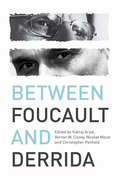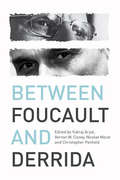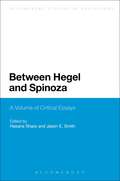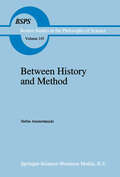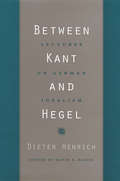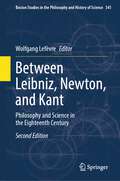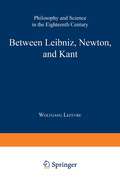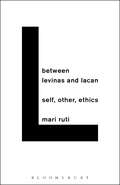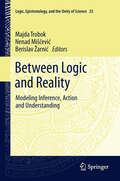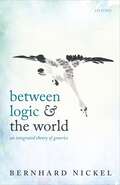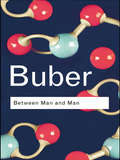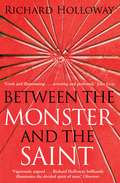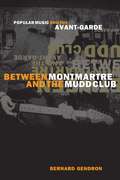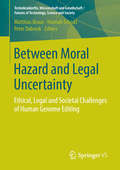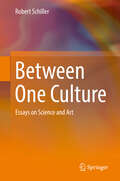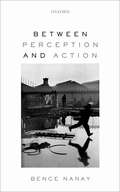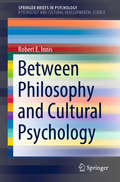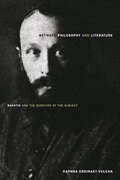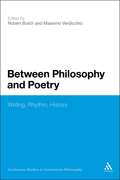- Table View
- List View
Between Foucault and Derrida
by Yubraj Aryal Vernon W. CisneyDerrida and Foucault are unquestionably two of the most influential philosophers of the 20th century. Both share a similar motivation to challenge our fundamental structures of meaning – in texts, political structures, and epistemic and discursive practices – in order to inspire new ways of thinking. Between Foucault and Derrida explores the notorious Cogito debate and includes: the central articles, an important piece by Jean-Marie Beyssade, along with a letter Foucault wrote to Beyssade in response – both these pieces available for the first time in English translation. In the second part of the book, 10 essays written by some of the most well-known scholars working in contemporary continental philosophy address the various philosophical intersections and divergences of these two profoundly important thinkers.
Between Foucault and Derrida
by Yubraj Aryal Vernon W. CisneyDerrida and Foucault are unquestionably two of the most influential philosophers of the 20th century. Both share a similar motivation to challenge our fundamental structures of meaning – in texts, political structures, and epistemic and discursive practices – in order to inspire new ways of thinking. Between Foucault and Derrida explores the notorious Cogito debate and includes: the central articles, an important piece by Jean-Marie Beyssade, along with a letter Foucault wrote to Beyssade in response – both these pieces available for the first time in English translation. In the second part of the book, 10 essays written by some of the most well-known scholars working in contemporary continental philosophy address the various philosophical intersections and divergences of these two profoundly important thinkers.
Between Hegel and Spinoza: A Volume of Critical Essays (Bloomsbury Studies in Philosophy)
by Hasana Sharp Jason E. SmithRecentwork in political philosophy and the history of ideas presents Spinoza andHegel as the most powerful living alternatives to mainstream Enlightenmentthought. Yet, for many philosophers and political theorists today, one mustchoose between Hegel or Spinoza. As Deleuze's influential interpretationmaintains, Hegel exemplifies and promotes the modern "cults of death," whileSpinoza embodies an irrepressible "appetite for living." Hegel is the figure ofnegation, while Spinoza is the thinker of "pure affirmation". Yet, betweenHegel and Spinoza there is not only opposition. This collection of essays seeksto find the suppressed kinship between Hegel and Spinoza. Both philosophersoffer vigorous and profound alternatives to the methodological individualism ofclassical liberalism. Likewise, they sketch portraits of reason that arecontext-responsive and emotionally contoured, offering an especially rich appreciationof our embodied and historical existence. The authors of this collectioncarefully lay the groundwork for a complex and delicate alliance between thesetwo great iconoclasts, both within and against the Enlightenment tradition.
Between Hegel and Spinoza: A Volume of Critical Essays (Bloomsbury Studies in Philosophy)
by Hasana Sharp Jason E. SmithRecentwork in political philosophy and the history of ideas presents Spinoza andHegel as the most powerful living alternatives to mainstream Enlightenmentthought. Yet, for many philosophers and political theorists today, one mustchoose between Hegel or Spinoza. As Deleuze's influential interpretationmaintains, Hegel exemplifies and promotes the modern "cults of death," whileSpinoza embodies an irrepressible "appetite for living." Hegel is the figure ofnegation, while Spinoza is the thinker of "pure affirmation". Yet, betweenHegel and Spinoza there is not only opposition. This collection of essays seeksto find the suppressed kinship between Hegel and Spinoza. Both philosophersoffer vigorous and profound alternatives to the methodological individualism ofclassical liberalism. Likewise, they sketch portraits of reason that arecontext-responsive and emotionally contoured, offering an especially rich appreciationof our embodied and historical existence. The authors of this collectioncarefully lay the groundwork for a complex and delicate alliance between thesetwo great iconoclasts, both within and against the Enlightenment tradition.
Between History and Method: Disputes about the Rationality of Science (Boston Studies in the Philosophy and History of Science #145)
by S. AmsterdamskiIn this book I have tried to develop further the ideas expressed in my previous work, Between Experience and Metaphysics, which was published in the same series in 1975. Several years have passed since the original Polish edition (and then 1 the Italian translation) of this book appeared. The fact that the principal ideas expressed in it have withstood, as I see it, the brunt of criticism, has led me to remain basically with the original text. Two main changes have, however, been introduced. First, I have added an Appendix containing the original version of a paper I presented at the Wissenschaftskolleg zu Berlin in June 1988 and a short postscript to that paper referring to comments made during two dis cussions at the Kolleg. Let me briefly explain the reason for this addition. In recent years the landscape for historical and philosophical in terpretation of the evolution of scientific knowledge has altered. The strongest of the new contenders for epistemological recognition are social constructivists, who analyze in detail how knowledge is produced within specific social settings, including the instruments and procedures of par ticular laboratories and the economic and political realities of particular scientific communities. The local character of these studies raises the question of whether they can ever provide generalizable epistemological claims.
Between Kant and Hegel: Lectures on German Idealism
by Dieter HenrichElectrifying when first delivered in 1973, legendary in the years since, Dieter Henrich's lectures on German Idealism were the first contact a major German philosopher had made with an American audience since the onset of World War II. They remain one of the most eloquent explanations and interpretations of classical German philosophy and of the way it relates to the concerns of contemporary philosophy. Thanks to the editorial work of David Pacini, the lectures appear here with annotations linking them to editions of the masterworks of German philosophy as they are now available. Henrich describes the movement that led from Kant to Hegel, beginning with an interpretation of the structure and tensions of Kant's system. He locates the Kantian movement and revival of Spinoza, as sketched by F. H. Jacobi, in the intellectual conditions of the time and in the philosophical motivations of modern thought. Providing extensive analysis of the various versions of Fichte's Science of Knowledge, Henrich brings into view a constellation of problems that illuminate the accomplishments of the founders of Romanticism, Novalis and Friedrich Schlegel, and of the poet Hölderlin's original philosophy. He concludes with an interpretation of the basic design of Hegel's system.
Between Leibniz, Newton, and Kant: Philosophy and Science in the Eighteenth Century (Boston Studies in the Philosophy and History of Science #341)
by Wolfgang LefèvreThis addresses the transformations of metaphysics as a discipline, the emergence of analytical mechanics, the diverging avenues of 18th-century Newtonianism, the body-mind problem, and philosophical principles of classification in the life sciences. An appendix contains a critical edition and first translation into English of Newton's scholia from David Gregory's Estate on the Propositions IV through IX Book III of his Principia.
Between Leibniz, Newton, and Kant: Philosophy and Science in the Eighteenth Century (Boston Studies in the Philosophy and History of Science #220)
by WolfgangLefèvreThis addresses the transformations of metaphysics as a discipline, the emergence of analytical mechanics, the diverging avenues of 18th-century Newtonianism, the body-mind problem, and philosophical principles of classification in the life sciences. An appendix contains a critical edition and first translation into English of Newton's scholia from David Gregory's Estate on the Propositions IV through IX Book III of his Principia.
Between Levinas and Lacan: Self, Other, Ethics
by Mari RutiLevinas and Lacan, two giants of contemporary theory, represent schools of thought that seem poles apart. In this major new work, Mari Ruti charts the ethical terrain between them. At first glance, Levinansian and Lacanian approaches may seem more or less incompatible, and in many ways they are, particularly in their understanding of the self-other relationship. For both Levinas and Lacan, the subject's relationship to the other is primary in the sense that the subject, literally, does not exist without the other, but they see the challenge of ethics quite differently: while Levinas laments our failure to adequately meet the ethical demand arising from the other, Lacan laments the consequences of our failure to adequately escape the forms this demand frequently takes. Although this book outlines the major differences between Levinas and Judith Butler on the one hand and Lacan, Slavoj Žižek, and Alain Badiou on the other, Ruti proposes that underneath these differences one can discern a shared concern with the thorny relationship between the singularity of experience and the universality of ethics. Between Levinas and Lacan is an important new book for anyone interested in contemporary theory, ethics, psychoanalysis, and feminist and queer theory.
Between Levinas and Lacan: Self, Other, Ethics
by Mari RutiLevinas and Lacan, two giants of contemporary theory, represent schools of thought that seem poles apart. In this major new work, Mari Ruti charts the ethical terrain between them. At first glance, Levinansian and Lacanian approaches may seem more or less incompatible, and in many ways they are, particularly in their understanding of the self-other relationship. For both Levinas and Lacan, the subject's relationship to the other is primary in the sense that the subject, literally, does not exist without the other, but they see the challenge of ethics quite differently: while Levinas laments our failure to adequately meet the ethical demand arising from the other, Lacan laments the consequences of our failure to adequately escape the forms this demand frequently takes. Although this book outlines the major differences between Levinas and Judith Butler on the one hand and Lacan, Slavoj Žižek, and Alain Badiou on the other, Ruti proposes that underneath these differences one can discern a shared concern with the thorny relationship between the singularity of experience and the universality of ethics. Between Levinas and Lacan is an important new book for anyone interested in contemporary theory, ethics, psychoanalysis, and feminist and queer theory.
Between Logic and Reality: Modeling Inference, Action and Understanding (Logic, Epistemology, and the Unity of Science #25)
by Majda Trobok, Nenad Miščević and Berislav ŽarnićIs reality logical and is logic real? What is the origin of logical intuitions? What is the role of logical structures in the operations of an intelligent mind and in communication? Is the function of logical structure regulative or constitutive or both in concept formation? This volume provides analyses of the logic-reality relationship from different approaches and perspectives. The point of convergence lies in the exploration of the connections between reality – social, natural or ideal – and logical structures employed in describing or discovering it. Moreover, the book connects logical theory with more concrete issues of rationality, normativity and understanding, thus pointing to a wide range of potential applications. The papers collected in this volume address cutting-edge topics in contemporary discussions amongst specialists. Some essays focus on the role of indispensability considerations in the justification of logical competence, and the wide range of challenges within the philosophy of mathematics. Others present advances in dynamic logical analysis such as extension of game semantics to non-logical part of vocabulary and development of models of contractive speech act.
Between Logic and the World: An Integrated Theory of Generics
by Bernhard NickelBetween Logic and the World presents a theory of generic sentences and the kind-directed modes of thought they express. The theory closely integrates compositional semantics with metaphysics to solve the problem that generics pose: what do generics mean? Generic sentences are extremely simple, yet if there are patterns to be discerned in terms of which are true and which are false, these patterns are subtle and complex. Ravens are black, lions have manes, sea-turtles are long-lived, and bishops in chess move along diagonals. Statistical measures cannot do justice to the facts, but what else is there that at least has a hope of giving us insight into what we are capturing across so many domains? Bernhard Nickel argues that generics are the top of a fundamentally explanatory iceberg. By focusing on blackness in ravens and manes in lions, for instance, we can place the kinds into a framework structured by explanatory considerations. Between Logic and the World argues that this explanatory framework is deeply intertwined with the semantics of the language we use to express them, and in giving its integrated semantic and metaphysical theory of generics, it aims to solve old puzzles and draw attention to new phenomena.
Between Man and Man
by Martin BuberScholar, theologian and philosopher, Martin Buber is one of the twentieth century's most influential thinkers. He believed that the deepest reality of human life lies in the relationship between one being and another. Between Man and Man is the classic work where he puts this belief into practice, applying it to the concrete problems of contemporary society. Here he tackles subjects as varied as religious ethics, social philosophy, marriage, education, psychology and art. Including some of his most famous writings, such as the masterful What is Man?, this enlightening work challenges each reader to reassess their encounter with the world that surrounds them.
Between Man and Man
by Martin BuberScholar, theologian and philosopher, Martin Buber is one of the twentieth century's most influential thinkers. He believed that the deepest reality of human life lies in the relationship between one being and another. Between Man and Man is the classic work where he puts this belief into practice, applying it to the concrete problems of contemporary society. Here he tackles subjects as varied as religious ethics, social philosophy, marriage, education, psychology and art. Including some of his most famous writings, such as the masterful What is Man?, this enlightening work challenges each reader to reassess their encounter with the world that surrounds them.
Between The Monster And The Saint: Reflections on the Human Condition
by Richard HollowayBeing human isn’t easy. We might think that consciousness and free will give us control over our lives but our minds are unpredictable places. We are susceptible to forces we don’t understand. We are capable of inflicting immense cruelty on one another and yet we also have the capacity to be tender, to empathise, to feel. In his thought-provoking new book Richard Holloway holds a mirror up to the human condition. By drawing on a colourful and eclectic selection of writings from history, philosophy, science, poetry, theology and literature, Holloway shows us how we can stand up to the seductive power of the monster and draw closer to the fierce challenge of the saint.
Between Montmartre and the Mudd Club: Popular Music and the Avant-Garde
by Bernard GendronDuring the late nineteenth and early twentieth century, popular music was considered nothing but vulgar entertainment. Today, jazz and rock music are seen as forms of art, and their practitioners are regularly accorded a status on par with the cultural and political elite. To take just one recent example, Bono, lead singer and lyricist of the rock band U2, got equal and sometimes higher billing than Pope John Paul II on their shared efforts in the Jubilee 2000 debt-relief project. When and how did popular music earn so much cultural capital? To find out, Bernard Gendron investigates five key historical moments when popular music and avant-garde art transgressed the rigid boundaries separating high and low culture to form friendly alliances. He begins at the end of the nineteenth century in Paris's Montmartre district, where cabarets showcased popular music alongside poetry readings in spaces decorated with modernist art works. Two decades later, Parisian poets and musicians "slumming" in jazz clubs assimilated jazz's aesthetics in their performances and compositions. In the bebop revolution in mid-1940s America, jazz returned the compliment by absorbing modernist devices and postures, in effect transforming itself into an avant-garde art form. Mid-1960s rock music, under the leadership of the Beatles, went from being reviled as vulgar music to being acclaimed as a cutting-edge art form. Finally, Gendron takes us to the Mudd Club in the late 1970s, where New York punk and new wave rockers were setting the aesthetic agenda for a new generation of artists. Between Montmartre and the Mudd Club should be on the shelves of anyone interested in the intersections between high and low culture, art and music, or history and aesthetics.
Between Montmartre and the Mudd Club: Popular Music and the Avant-Garde
by Bernard GendronDuring the late nineteenth and early twentieth century, popular music was considered nothing but vulgar entertainment. Today, jazz and rock music are seen as forms of art, and their practitioners are regularly accorded a status on par with the cultural and political elite. To take just one recent example, Bono, lead singer and lyricist of the rock band U2, got equal and sometimes higher billing than Pope John Paul II on their shared efforts in the Jubilee 2000 debt-relief project. When and how did popular music earn so much cultural capital? To find out, Bernard Gendron investigates five key historical moments when popular music and avant-garde art transgressed the rigid boundaries separating high and low culture to form friendly alliances. He begins at the end of the nineteenth century in Paris's Montmartre district, where cabarets showcased popular music alongside poetry readings in spaces decorated with modernist art works. Two decades later, Parisian poets and musicians "slumming" in jazz clubs assimilated jazz's aesthetics in their performances and compositions. In the bebop revolution in mid-1940s America, jazz returned the compliment by absorbing modernist devices and postures, in effect transforming itself into an avant-garde art form. Mid-1960s rock music, under the leadership of the Beatles, went from being reviled as vulgar music to being acclaimed as a cutting-edge art form. Finally, Gendron takes us to the Mudd Club in the late 1970s, where New York punk and new wave rockers were setting the aesthetic agenda for a new generation of artists. Between Montmartre and the Mudd Club should be on the shelves of anyone interested in the intersections between high and low culture, art and music, or history and aesthetics.
Between Moral Hazard and Legal Uncertainty: Ethical, Legal and Societal Challenges of Human Genome Editing (Technikzukünfte, Wissenschaft und Gesellschaft / Futures of Technology, Science and Society)
by Matthias Braun Hannah Schickl Peter DabrockGenome Editing Techniques are seen to be at the frontier of current research in the field of emerging biotechnologies. The latest revolutionary development, the so-called CRISPR technology, represents a paradigmatic example of the ambiguity of such techniques and has resulted in an international interdisciplinary debate on whether or not it is necessary to ban the application of this technique by means of a moratorium on its use for human germline modifications, particularly in human embryos in the reproduction process. However, given that other germline engineering techniques like mitochondrial (mt) DNA transfer techniques are already permitted and applied, the question arises what lies at the root of the apparent social unease about the modification of the human germline by Genome Editing Techniques like CRISPR. Against this background, the book seeks to make a substantial contribution to the current debate about a responsible and participatory framework for research on emerging biotechnologies by analysing underlying perceptions, attitudes, arguments and the reasoning on Genome Editing Techniques.
Between Naturalism and Religion: Philosophical Essays
by Jürgen HabermasTwo countervailing trends mark the intellectual tenor of our age – the spread of naturalistic worldviews and religious orthodoxies. Advances in biogenetics, brain research, and robotics are clearing the way for the penetration of an objective scientific self-understanding of persons into everyday life. For philosophy, this trend is associated with the challenge of scientific naturalism. At the same time, we are witnessing an unexpected revitalization of religious traditions and the politicization of religious communities across the world. From a philosophical perspective, this revival of religious energies poses the challenge of a fundamentalist critique of the principles underlying the modern Wests postmetaphysical understanding of itself. The tension between naturalism and religion is the central theme of this major new book by Jürgen Habermas. On the one hand he argues for an appropriate naturalistic understanding of cultural evolution that does justice to the normative character of the human mind. On the other hand, he calls for an appropriate interpretation of the secularizing effects of a process of social and cultural rationalization increasingly denounced by the champions of religious orthodoxies as a historical development peculiar to the West. These reflections on the enduring importance of religion and the limits of secularism under conditions of postmetaphysical reason set the scene for an extended treatment the political significance of religious tolerance and for a fresh contribution to current debates on cosmopolitanism and a constitution for international society.
Between Naturalism and Religion: Philosophical Essays
by Jürgen HabermasTwo countervailing trends mark the intellectual tenor of our age – the spread of naturalistic worldviews and religious orthodoxies. Advances in biogenetics, brain research, and robotics are clearing the way for the penetration of an objective scientific self-understanding of persons into everyday life. For philosophy, this trend is associated with the challenge of scientific naturalism. At the same time, we are witnessing an unexpected revitalization of religious traditions and the politicization of religious communities across the world. From a philosophical perspective, this revival of religious energies poses the challenge of a fundamentalist critique of the principles underlying the modern Wests postmetaphysical understanding of itself. The tension between naturalism and religion is the central theme of this major new book by Jürgen Habermas. On the one hand he argues for an appropriate naturalistic understanding of cultural evolution that does justice to the normative character of the human mind. On the other hand, he calls for an appropriate interpretation of the secularizing effects of a process of social and cultural rationalization increasingly denounced by the champions of religious orthodoxies as a historical development peculiar to the West. These reflections on the enduring importance of religion and the limits of secularism under conditions of postmetaphysical reason set the scene for an extended treatment the political significance of religious tolerance and for a fresh contribution to current debates on cosmopolitanism and a constitution for international society.
Between One Culture: Essays on Science and Art
by Robert SchillerThis book argues that science and the arts are not two different cultures, but rather different manifestations of the same culture. Divided into seven parts, it presents a collection of translated and revised essays, mostly at the intersection between realia and humaniora. In the first two parts, the author discusses how some myths, both ancient and modern, have become intertwined with scientific ideas. The chapters in the following four parts address poems, novels, plays, and pieces of fine art that have some scientific content, as well as scientific findings which seem to have also been discovered in art. The chapters in the final part examine a number of inspiring doubts and necessary errors in the history of science. This collection of essays, most of which were originally published in Hungarian, is intended for the general public and as such includes no mathematical, physical or chemical formulae. It offers a unique resource for all those curious about the interconnections between science, art and literature.
Between Perception and Action
by Bence NanayWhat mediates between sensory input and motor output? This is probably the most basic question one can ask about the mind. There is stimulation on your retina, something happens in your skull and then you hand reaches out to grab the apple in front of you. What is it that happens in between? What representations make it possible for you to grab this apple? Bence Nanay calls these representations that make it possible for you to grab the apple 'pragmatic representations'. In Between Perception and Action he argues that pragmatic representations whose function is to mediate between sensory input and motor output play an immensely important role in our mental life. And they help us to explain why the vast majority of what goes on in our mind is very similar to the simple mental processes of animals. The human mind, like the mind of non-human animals, has been selected for allowing us to perform actions successfully. And the vast majority of our actions, like the actions of non-human animals, could not be performed without perceptual guidance. And what provides the perceptual guidance for performing actions are pragmatic representations. If we accept this framework, many classic questions in philosophy of perception and of action will look very different. The aim of this book is to trace the various consequences of this way of thinking about the mind in a number of branches of philosophy as well as in psychology and cognitive science.
Between Philosophy and Cultural Psychology (SpringerBriefs in Psychology)
by Robert E. InnisThis Brief provides an in-depth discussion of five major points of intersection between philosophy and cultural psychology. The first chapter frames central analytical and normative threads, foregrounding the focal notion of thresholds of sense. The second chapter explores the nature of contexts, situations, and backgrounds of meaning-making following the lead of John Dewey, Ben-Ami Scharfstein, and Gernot Böhme. Chapter three examines the complementary analytical power of the semiotic resources developed in the work of Peirce, Bühler, and Cassirer. Chapter four shows the heuristic fertility and psychological bearing of Susanne Langer's feeling-based aesthetic model of minding. The final chapter establishes affectivation as the inescapable consequence of human beings giving life to themselves by giving life to signs. The Brief concludes with three commentaries from leading researchers in the area. The chapters weave together interlocking themes: the nature of embodied perception, the variety of contexts and semiotic frameworks and their schematization of thresholds of meaning-making, the role of art and theories of imagination both in cultural psychology and in philosophy, and the centrality of feeling in all forms of meaning-making. Between Philosophy and Cultural Psychology will be of interest to cognitive and cultural psychologists as well as researchers and upper-graduate students in philosophy and related psychology fields.
Between Philosophy and Literature: Bakhtin and the Question of the Subject
by Daphna Erdinast-VulcanThis is an original reading of Mikhail Bakhtin in the context of Western philosophical traditions and counter-traditions. The book portrays Bakhtin as a Modernist thinker torn between an ideological secularity and a profound religious sensibility, invariably concerned with questions of ethics and impelled to turn from philosophy to literature as another way of knowing. Most major studies of Bakhtin highlight the fragmented and apparently discontinuous nature of his work. Erdinast-Vulcan emphasizes, instead, the underlying coherence of the Bakhtinian project, reading its inherent ambivalences as an intersection of philosophical, literary, and psychological insights into the dynamics of embodied subjectivity. Bakhtin's turn to literature and poetry, as well as the dissatisfactions that motivated it, align him with three other "exilic" Continental philosophers who were his contemporaries: Bergson, Merleau-Ponty, and Levinas. Adopting Bakhtin's own open-ended approach to the human sciences, the book stages a series of philosophical encounters between these thinkers, highlighting their respective itineraries and impasses, and generating a Bakhtinian synergy of ideas.
Between Philosophy and Poetry: Writing, Rhythm, History (Continuum Collection Ser.)
by Massimo Verdicchio Robert BurchBetween Philosophy and Poetry examines the complex and controversial relation that has informed literary theory since ancient times: the difference between philosophy and poetry. The book explores three specific areas: the practice of writing with respect to orality; the interpretive modes of poetic and philosophical discourse as self-narration and historical understanding; how rhythm marks the differential spaces in poetry and philosophy. The book brings together some of the most prominent international scholars in the fields of philosophy and literature to examine the differences between orality and writing, the signs and traces of gender in writing, the historical dimension of the tension between philosophical and poetic language, and the future possibility of a musical thinking that would go beyond the opposition between philosophy and poetry. In the final instance, rhythm is the force to be reckoned with and is the essential element in an understanding of philosophy and poetry. Rhythm in effect provides a musical ethics of philosophy, for musical thinking goes beyond the metaphysical opposition between philosophy and poetry and sets the frame for post-philosophical practice.Contributors: Amittari F. Aviram, Babette Babich , Eve Taylor Bannet, Stephen Barker, Alexandro Carrera, Richard Detsch, Karen Feldman, David Halliburton, Richard Kearney, Carlo Sini, P. Christopher Smith, Forrest Williams
